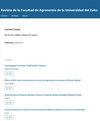Emergence capacity and seedlings early growth of four legumes in arid zones under NaCl-stress
IF 0.5
4区 农林科学
Q4 AGRONOMY
Revista De La Facultad De Agronomia De La Universidad Del Zulia
Pub Date : 2023-06-02
DOI:10.47280/revfacagron(luz).v40.n2.10
引用次数: 0
Abstract
Legumes are used as fodder and green manures, because of fix nitrogen biologically. The objective of this study was to determine the emergence capacity and the early growth of four legume species treated with different NaCl-stress concentrations. The experiment was established in a completely randomized design with a factorial arrangement, where the first factor was the four legumes’ species (Vigna unguiculata L. Walp., Lablab purpureus (L.) Sweet, Clitoria ternatea L. and Canavalia ensiformis L. DC.) and the second factor was NaCl concentrations (0.25, 50, and 75 mM) with 16 treatments and four replications. The variables evaluated were emergence rate and percentage, stem and root length, fresh and dry weight of stem+leaves and root, stem and root length, stem diameter and the ratio of stems+leaves dry weight and roots dry weight (plant balance). The results showed that all variables expressed significant differences between species, NaCl and the species × NaCl interaction. A differential response between legumes to NaCl stress was observed. The most tolerant species to NaCl were Vigna unguiculata and Canavalia ensiformis showed a higher tolerance with respect to Lablab purpureus and Clitoria ternatea.nacl胁迫下干旱区4种豆科植物出苗率及幼苗早期生长
豆科植物被用作饲料和绿色肥料,因为它具有生物固氮作用。研究了4种豆科植物在不同nacl胁迫下的羽化能力和早期生长情况。试验采用全随机设计和因子设计,以四种豆科植物(Vigna unguiculata L. Walp)为第一因子;Lablab purpureus (L.)NaCl浓度(0.25、50和75 mM), 16个处理,4个重复。评价变量为出苗率和出苗率、茎和根长、茎+叶和根的鲜重和干重、茎和根长、茎直径以及茎+叶干重和根干重之比(植株平衡)。结果表明,各变量在种间、NaCl间及种与NaCl间的相互作用均表现出显著差异。不同豆科植物对NaCl胁迫的响应存在差异。对NaCl的耐受性最强的品种为荆芥(Vigna unguguulata),而对紫菜(Lablab purpureus)和阴蒂(Clitoria ternates)耐受性较强的品种为Canavalia ensiformis。
本文章由计算机程序翻译,如有差异,请以英文原文为准。
求助全文
约1分钟内获得全文
求助全文
来源期刊
CiteScore
0.50
自引率
0.00%
发文量
45
审稿时长
>12 weeks
期刊介绍:
La Revista de la Facultad de Agronomía de la Universidad del Zulia publica artículos científicos, notas técnicas, comunicaciones rápidas y artículos invitados originales e inéditos, es decir, que no hayan sido publicados ni enviados simultáneamente a otra revista para su publicación, de autores interesados en el campo agrícola vegetal y agrícola animal. De presentarse el caso que el autor o autores hubiesen enviado o publicado su manuscrito simultáneamente en otra revista, podrán ser sancionados con la no publicación en esta revista por tiempo indefinido.
Se admiten manuscritos escritos en idioma Español, Portugués o Inglés, con un resumen en Español o Portugués y otro en Inglés (Abstract).

 求助内容:
求助内容: 应助结果提醒方式:
应助结果提醒方式:


